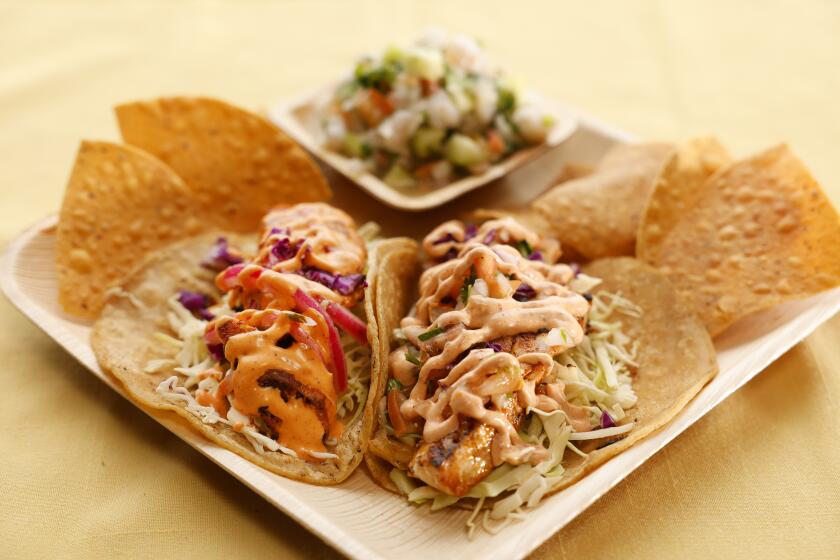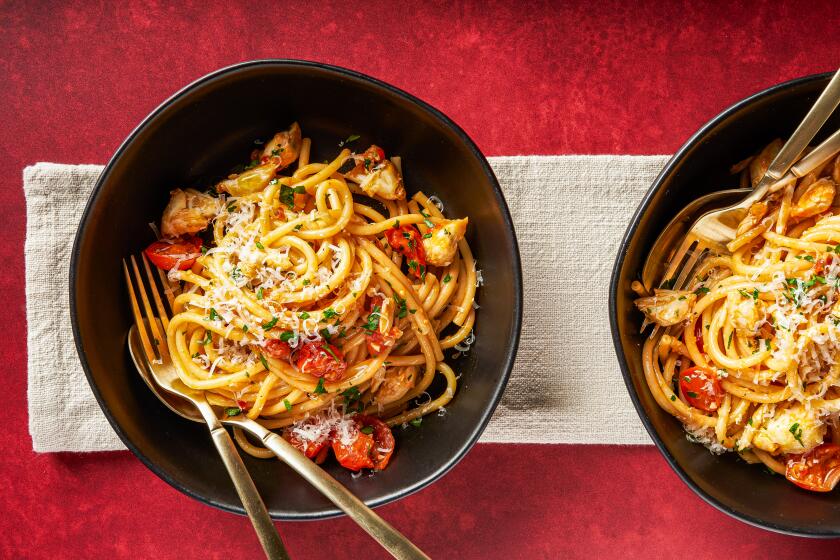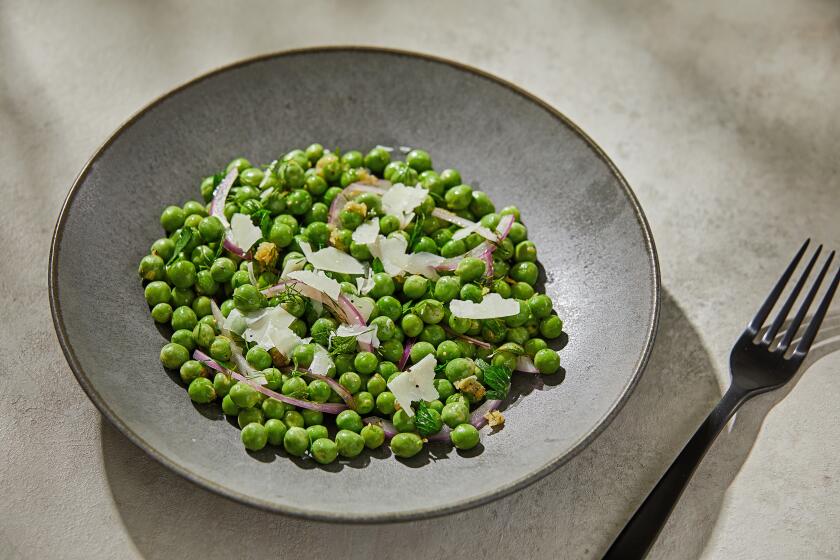Small but mighty habanero brings so much more than heat to dishes
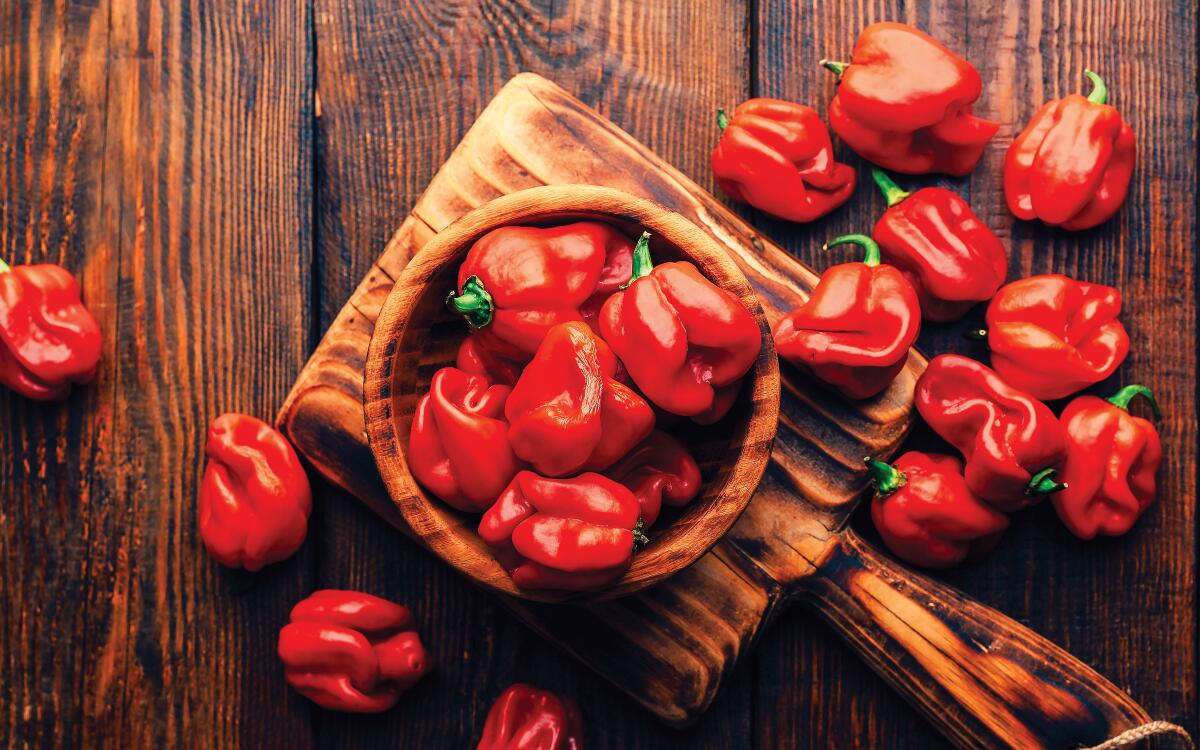
The versatile chile that rules Yucatán offers tangy, fruity spiciness to salsas, salads, meats and more
It doesn’t matter if you are at a hotel, restaurant, market, street-food stand or the home of a local in Yucatán, Mexico — if salsa de mesa, or table salsa, is not there when you sit down, you can count the minutes until someone quickly mashes some together or opens the refrigerator to pour some into a bowl.
In Yucatán, people drizzle it over, spoon it onto and dip into it everything except dessert. It is so ubiquitous that, like table salt, it needs no other descriptor. But everyone knows what it is made of: the small but mighty habanero chile, roasted and mashed with just enough sour orange juice and a pinch of salt to make it salsa-ble.
Within the vast and diverse foodways of Mexico, chiles shape the personality of regional cuisines. In Chihuahua, it is the fresh chilaca chile, which is called chile Colorado when dried. In Sonora, it’s the fresh or dried chiltepín. In Michoacán, it is the dried pasilla, and in Veracruz, the jalapeño. In Yucatán, the habanero is king. If it is not already part of a dish, the obligatory salsa de mesa stands by to add zing and heat.
“The habanero is the life of our cuisine,” said Elio Xicum, a chef who grew up and still lives in Yucatán. “If our food doesn’t have habanero in it, or at least on the side of it, it is halfhearted.”
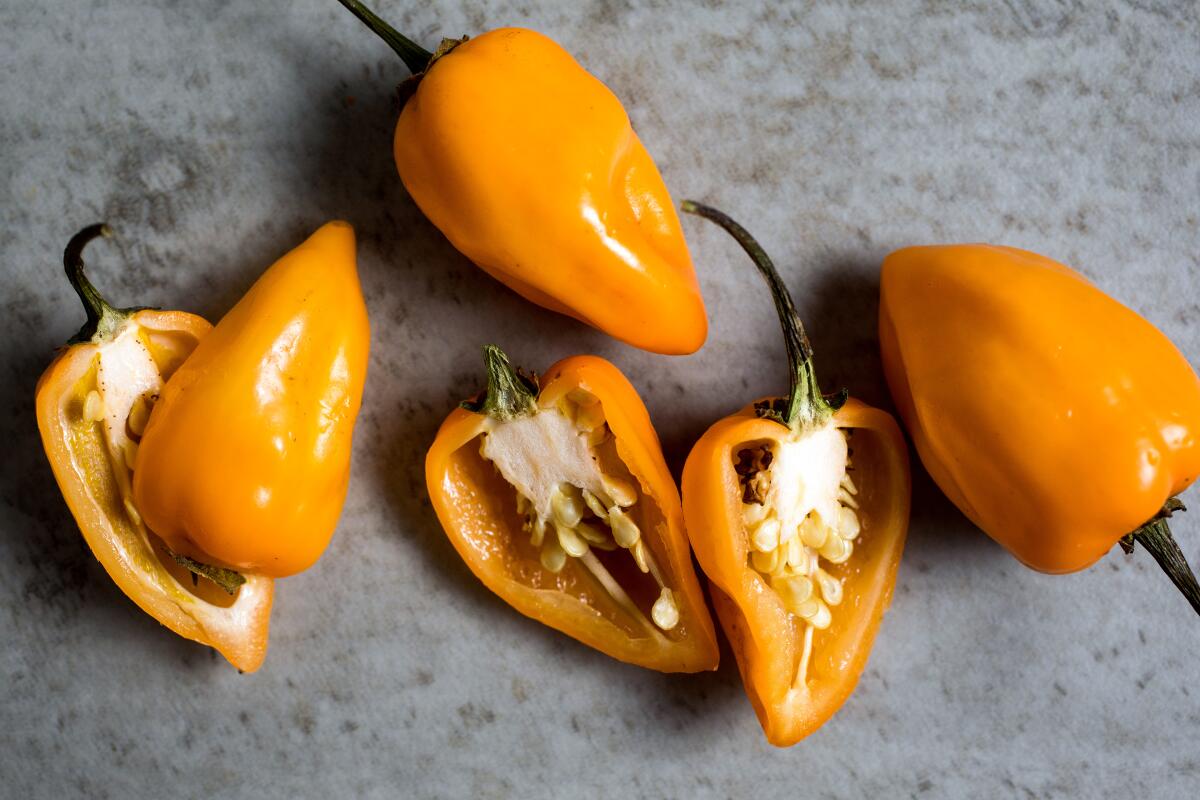
The habanero originated in the Amazon basin, said Wilson Alonzo, a chef and culinary historian in Halachó, Yucatán. It spread to the Yucatán Peninsula, and by colonial times, it had become a major export to Cuba. Its name comes from the Cuban province La Habana.
“Here, it took root, thrived, its flavors and heat fully developed to its prime,” Alonzo said. “We have the conditions that led to our having the denomination of origin,” he added, referring to the protective status given to products from particular countries and regions.
The habanero’s consumption was largely confined to the Yucatán Peninsula until about a decade ago, but the chile has grown popular across Mexico, where it is used mainly for salsas. In the last few years, it has become trendy north of the Mexican border as a marketable flavor for snacks and pantry products like potato chips, chile crisp and precooked rice.
But much more than heat makes the habanero a culinary charmer worth bringing into your home.
Shaped like a small lantern no more than 2 inches long, the habanero comes in deep, vibrant colors, primarily green, yellow, orange and red. It is shiny and a bit waxy, with a smooth skin and broad shoulders that fall into curvy ridges on its sides. Its playful looks are deceiving: The heat is much more concentrated at the top, along its veins and in its seeds, but dissipates at the tip.
The habanero tastes fruity, citrusy and flowery before it hits you with a lingering kick that delightfully tickles the tongue. The habanero is least ripe when green, and its taste a bit more bitter and acidic. As it ripens, its color goes to yellow, then orange and finally red. The riper it is, the fruitier it gets, becoming increasingly fragrant and sweet, and losing its acidity.
After spending time in the Yucatán Peninsula, I have taken cues from Yucatecan cooks for taming the habanero’s heat and making the most of its varied flavors. The first is to add habanero a little bit at a time as you cook, instead of all at once. You can always add heat, but it’s hard to remove. The second is that there’s no need for gloves unless you are cooking with heaps of them. Just wash your hands with soapy water and you are good to go.
When fresh, habaneros have a crisp and pungent taste as well as a watery crunch. One of the best ways to prepare the fresh chile is to stem, seed and finely chop it, then mix it with a sliced raw onion, a bit of lime juice and salt. This makes a phenomenal condiment for tacos, tortas or tostadas, or to eat as a spicy pico de gallo. You can also puree a fresh habanero to use in sauces, soups, stews or marinades, as in my recipe for roasted habanero chicken with broccoli, which is barely spicy but lets the flavors of the habanero shine through.
Roasting or charring habaneros pushes their sweet, fruity perfume forward and adds a layer of rustic smokiness, which you can taste in a crunchy salad with a creamy avocado and habanero dressing. I also like to roast or char and then cook down the habaneros further for a multipurpose tomato salsa.
Many Yucatecan cooks opt to leave the habanero whole in salsas, stews or soups. Doing so infuses dishes with some of its flavors, but none of the heat, and allows eaters to hunt for the chile and break it into their own serving for heat if they crave it. The flavor and spice are so transfixing, people will fight to get the cooked habanero onto their plates.
After seeing so many habaneros eaten this way, I understood why the salsa de mesa is an essential Yucatecan staple. Try it on anything. Well, everything except dessert.

Tomato-Habanero Salsa
With only three main ingredients — tomatoes, onion and habanero — this chunky, saucy, salsa is bold, simple and beautiful in its simplicity and multiple uses. The roasted tomato leads, slightly smoky with an acidic tang; the roasted onion provides sweetness; and the habanero provides a bright pop of flavor that transforms into a light yet spicy kick that lingers and tickles the tongue. The salsa is as versatile as it is addictive: Dip it with chips, or spoon it over sunny-side-up eggs huevos rancheros style, grilled meats, cheesy quesadillas, crispy taquitos or avocado toast. It also makes a quick, lively breakfast: Spoon about ¼ cup salsa into a heated small skillet and pour a couple of whisked eggs on top for a quick egg scramble with a side of toast.
Makes about 2 cups
1½ pounds whole ripe Roma tomatoes (about 6 to 8)
½ medium white onion (about 4 to 5 ounces), peeled and quartered into 4 thin wedges
1 fresh habanero
2 tablespoons vegetable oil
¾ teaspoon coarse kosher or sea salt, or more to taste
Place tomatoes, onion and habanero on a baking sheet. Set them under the broiler, for about 12 to 16 minutes, rotating the ingredients as needed and peeking frequently, until charred and blistered on all sides, and tomatoes are soft and mushy, with their juices starting to come out. You may need to remove the habanero a few minutes before the tomatoes and onion. (Alternatively, you can toast or char the ingredients on a preheated comal, skillet or griddle set over medium heat, though it may take a few minutes more.) Remove from the heat.
In a large cutting board, remove the stem and seeds from the habanero and finely chop. Also finely chop the onions then the tomatoes (but don’t remove their skin, core or seeds).
In a medium saucepan, heat the oil over medium. Once hot, add the tomatoes, onion, habanero and salt; stir to combine. Cover with the lid, reduce heat to medium-low and cook for 8 to 10 minutes, until the flavors come together and the salsa gains a slightly deeper color. (It should still be very wet.) Taste for salt and add more if need be. To store the salsa, let it cool, then cover it and refrigerate for up to 1 week.

Habanero Chicken and Broccoli
In this bright, tangy sheet-pan dish, the chicken gets a quick first roast covered in a light oregano and garlic marinade. That quick warmup is followed by a stellar run: The chicken is flipped, broccoli florets get tucked all around and a sweet citrus sauce with the slightest habanero kick drenches the mix. The sauce adds flavor and moisture to the chicken as it roasts and browns, and soaks the broccoli, which chars and tenderizes. Although this can be a complete meal on its own, the ample sauce is so flavorful that you may find yourself craving for something else to soak in it. Rice is the perfect cheerleader to round up the race. The habanero’s heat is tamed by citrus, allowing its zesty and flowery flavors to shine.
Makes 4 servings
¾ cup olive oil
6 garlic cloves, 5 finely chopped and 1 left whole
2 teaspoons dried oregano, crumbled
1 tablespoon plus 1 teaspoon kosher or coarse sea salt
1½ teaspoons ground black pepper
4 whole bone-in, skin-on chicken legs or 8 thighs
⅓ cup freshly squeezed lime juice (from 3 to 4 limes)
½ cup freshly squeezed lemon juice (from 2 lemons)
3 tablespoons honey
1 fresh habanero, stemmed
2 pounds broccoli (about 2 large heads), cut into large florets then halved lengthwise
Cooked rice, for serving
Heat the oven to 425 degrees and position the rack in the middle.
In a small bowl, combine ¼ cup of the olive oil with the finely chopped garlic, 1 teaspoon oregano, 1 teaspoon salt and ½ teaspoon pepper. Mix well. Rub all over the chicken pieces and place them skin side down in a large sheet pan.
In a blender, add the remaining ½ cup olive oil, 1 teaspoon oregano, 1 whole garlic clove, plus the lime juice, lemon juice, honey, habanero, 1 tablespoon salt and 1 teaspoon pepper. Puree until completely smooth.
Roast the chicken in the oven for 15 minutes. Remove from the oven, carefully release and flip the chicken pieces using a spatula, and arrange the halved broccoli florets between the chicken pieces. Pour the blended habanero sauce all over the broccoli.
Place back in the oven to roast for another 25 minutes. The chicken should have browned on top and be fully cooked and the broccoli should be a bit charred on the outside but still retain some crunch.
Divide the chicken and the broccoli among plates, along with rice, if desired. Spoon the sauce from the sheet pan over the top.
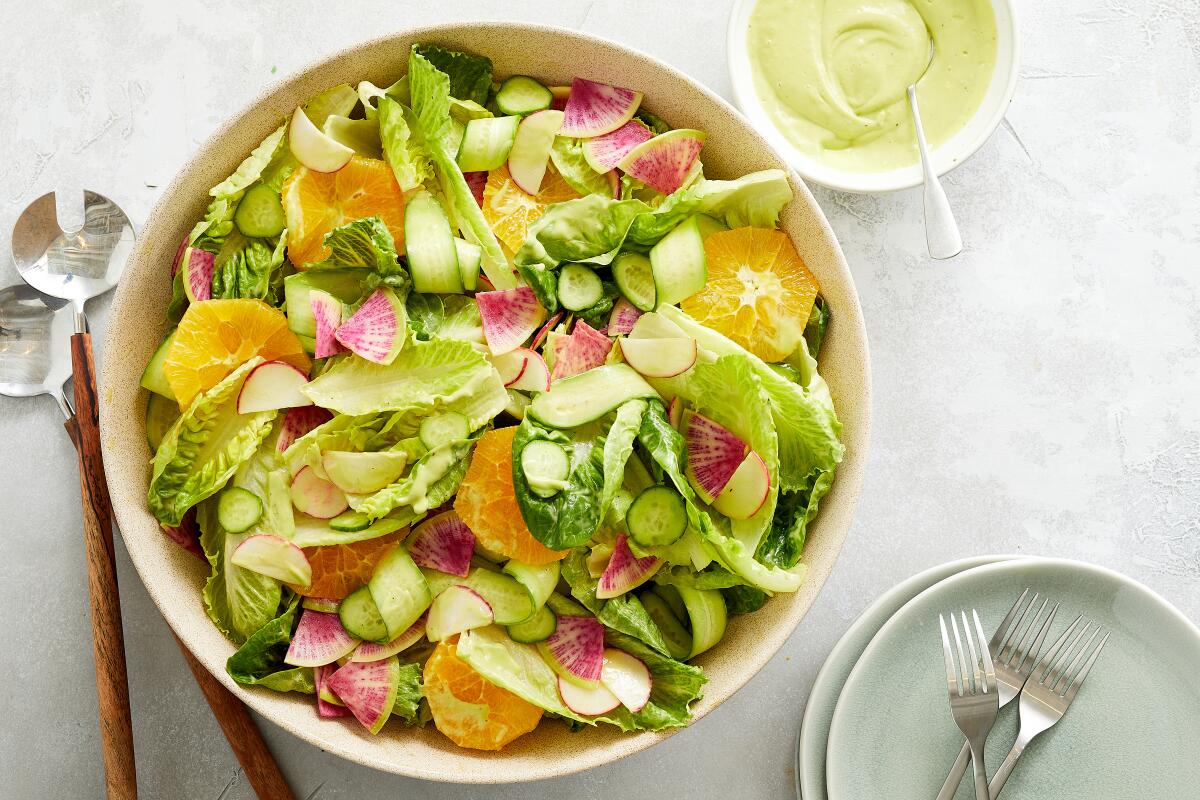
Tangy Romaine Salad With Habanero-Avocado Dressing
Tender lettuce, juicy sweet oranges, pungent radishes and crunchy cucumbers get a lush treatment with this creamy, tangy, rich, addictingly spicy dressing that leaves a luxuriously rich and full mouthfeel after each bite. The habanero becomes sweeter and its flavors more bold as it roasts, imparting zesty, peppy flavor, feisty bite and a hint of rustic smoke to the creamy avocado dressing. This dressing works well on any green salad — but is so good you might even want to pour it onto a bowl and eat with a spoon.
Makes 4 to 6 servings
1 fresh habanero chile
1 large ripe avocado, halved, pitted and diced
6 tablespoons olive oil
⅓ cup freshly squeezed lime juice
2 tablespoons white distilled vinegar
2 teaspoons dark brown sugar
1¼ teaspoons kosher or sea salt, or more to taste
½ teaspoon freshly ground black pepper
2 heads romaine or 3 to 4 heads baby romaine, washed, dried and torn into pieces
3 mini cucumbers (about 8 ounces), rinsed, ends removed and sliced
3 to 4 radishes, rinsed, halved and thinly sliced
3 to 4 large oranges, peeled and cut into supremes or slices (about 1 cup)
In a preheated comal, skillet or griddle set over medium heat, toast and char the habanero for 6 to 8 minutes, flipping as needed, until skin is charred and chile completely softened. Remove from the heat. Using a fork and a knife, halve the chile, then remove the stem and scrape the seeds off. (If you use your hands, be sure to rinse with soap and water as habaneros are spicy.)
In the jar of a blender, add half the roasted chile plus the avocado, olive oil, lime juice, vinegar, sugar, salt, pepper and 2 tablespoons of water. Puree until completely smooth. Taste for spiciness level and salt and adjust to taste, adding the remaining habanero if desired.
To a large bowl, add the lettuce, and about ¾ of the cucumbers, radishes and orange supremes. Toss with about ¾ of the dressing until completely covered. Add the remaining cucumbers, radishes and orange supremes on top. Add more dressing as desired.
Recipes by Pati Jinich.
Jinich is a Mexican chef, cookbook author, educator and food writer known for her James Beard award-winning public television series “Pati’s Mexican Table.” This article appeared in The New York Times.
Get Essential San Diego, weekday mornings
Get top headlines from the Union-Tribune in your inbox weekday mornings, including top news, local, sports, business, entertainment and opinion.
You may occasionally receive promotional content from the San Diego Union-Tribune.
